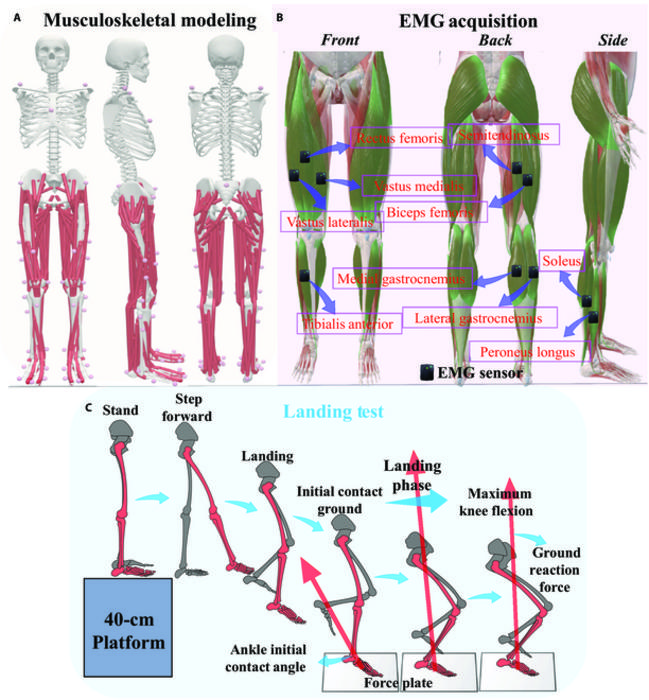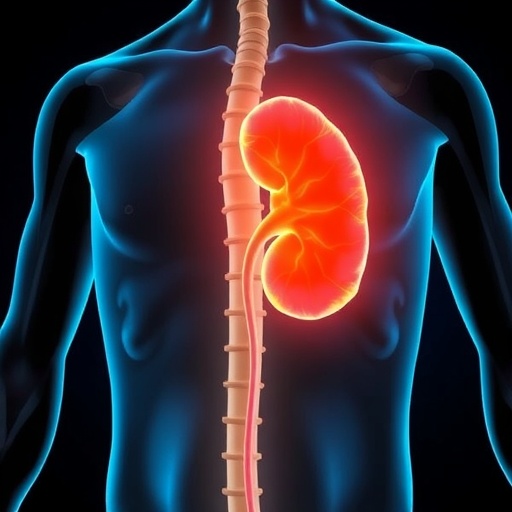The recent study by Datao Xu and his team at Ningbo University has unveiled important strategies that can be applied in athletic training and rehabilitation to curb the high rates of lower limb injuries. Their research meticulously analyzes the mechanics of single-leg landings—a common move in various sports—to propose enhanced landing techniques that not only aim to protect athletes but also improve their performance by enabling quicker recovery and continuation in sports activities.

Credit: Cyborg and Bionic Systems
The recent study by Datao Xu and his team at Ningbo University has unveiled important strategies that can be applied in athletic training and rehabilitation to curb the high rates of lower limb injuries. Their research meticulously analyzes the mechanics of single-leg landings—a common move in various sports—to propose enhanced landing techniques that not only aim to protect athletes but also improve their performance by enabling quicker recovery and continuation in sports activities.
One of the study’s most significant contributions is its detailed exploration of the role of ankle dynamics in absorbing landing impacts. Findings indicate that an ankle’s initial contact angle (AICA) of 30° to 40° and a range of motion (AROM) of 50° to 70° are optimal for minimizing the risk of ACL injuries while also mitigating the possibility of ankle sprains. These specific parameters help distribute the impact forces more evenly across the lower limb, thereby reducing the load on any single joint.
The implications of these findings are profound for sports coaching and training methodologies. Coaches and trainers can implement these biomechanically optimized landing strategies in their routine training sessions to teach athletes how to land more safely. Moreover, the study advocates for targeted strength and flexibility training to further support the ankle’s ability to handle increased AICA and AROM. Such training can significantly enhance the structural integrity of the ankle and knee, providing a dual benefit of performance enhancement and injury prevention.
The research also addresses the need for personalized training programs. Given the variability in individual biomechanics, what works as an optimal landing strategy for one athlete may not be suitable for another. This personalization is crucial in sports medicine and training, where customized programs based on an athlete’s specific biomechanical profile can lead to better outcomes in terms of both performance and safety.
Furthermore, the integration of technology in sports training, such as motion capture systems and biomechanical modeling software, could play a pivotal role in refining these strategies. These technologies can provide real-time feedback to athletes and coaches, allowing for immediate adjustments in training regimes and techniques.
The findings from Xu and his team set a new benchmark in sports science, particularly in the context of injury prevention. As this research filters into mainstream sports training programs, it could lead to significant reductions in the incidence of sports-related injuries, promoting longer and healthier careers for athletes.
Ultimately, this study is a crucial reminder of the delicate balance sports professionals must maintain between pushing the limits of human performance and ensuring safety. With continued research and the adoption of evidence-based practices, the field of sports science can lead the way in safeguarding athlete health while enhancing the thrilling performances that captivate sports enthusiasts around the world.
The paper, “New Insights Optimize Landing Strategies to Reduce Lower Limb Injury Risk” was published in the journal Cyborg and Bionic Systems on February 10, 2022, at DOI: https://spj.science.org/doi/10.34133/cbsystems.0126
###
Reference
Authors:
Datao Xu1, Huiyu Zhou1, Wenjing Quan1 , Xin Ma2 , Teo-Ee Chon1,3, Justin Fernandez4,5 , Fekete Gusztav6 , András Kovács7 , Julien S. Baker1,8 , and Yaodong Gu1*
Affiliations:
1 Faculty of Sports Science, Ningbo University, Ningbo, China.
2 Department of Orthopedics, Huashan Hospital, Fudan University, Shanghai, China.
3 School of Chemical and Biomedical Engineering, Nanyang Technological University, Singapore 639798, Singapore.
4 Auckland Bioengineering Institute, University of Auckland, Auckland, New Zealand.
5 Department of Engineering Science, University of Auckland, Auckland, New Zealand.
6 Department of Material Science and Technology, Audi Hungaria Faculty of Automotive Engineering, Széchenyi István University, Gyor, Hungary.
7 Faculty of Engineering, University of Pannonia, Veszprém, Hungary.
8 Department of Sport and Physical Education, Hong Kong Baptist University, Hong Kong, China.
Title of original paper: New Insights Optimize Landing Strategies to Reduce Lower Limb Injury Risk
Journal: Cyborg and Bionic Systems
DOI
10.34133/cbsystems.0126




